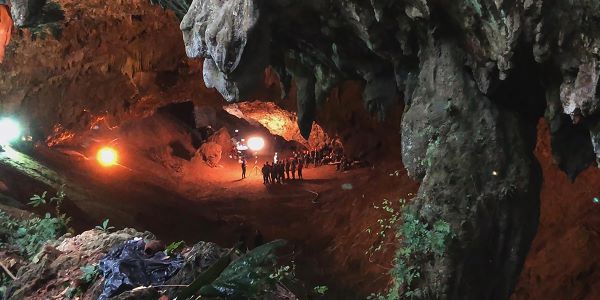
The miraculous 2018 rescue of a teenage soccer team trapped for 16 days in the underground Tham Luang cave in northern Thailand has been well-covered. Nevertheless, directors E. Chai Vasarhelyi and Jimmy Chin’s moment-to-moment and day-by-day retelling still feels fresh off the press. This weekend, it won the Toronto International Film Festival’s People Choice Documentary Award.
The filmmaking team behind the Oscar-winning Free Solo (2018), which also screened at the festival, have approached this well-known story from a particular angle that makes sense considering the previous film, which pondered the motivations of mountain climber Alex Honnold, who scales cliffs without any other apparatus, finding traction through the cracks within the mountain. In their new documentary, the filmmakers again examine what makes individuals drawn to extreme endeavors tick.
They focus on a buttoned-down brotherhood who were instrumental in saving the lives of the Thai teenagers. They’re mainly middle-age men from the United Kingdom and Australia who have a unique weekend hobby: cave diving. Self-described loners, many recall being bullied when they were younger, including Josh Bratchley, who was made fun of by other kids because of his lazy left eye.
Rick Stanton, a retired firefighter, and John Volanthen, an IT consultant, were first called to the rescue site by another Brit, Vern Unsworth, who had explored and updated Tham Luang’s map for Thailand’s National Park Service. (It’s the sixth largest cavern in the country.) In a rather strange coincidence, the event occurred in Chiang Rai, the hometown of nurse Amp Bangngoen, who had a two-week romance with Stanton while visiting England.
In the early days of the rescue attempt, Stanton and Volanthen were surprised to discover Thai water pump workers trapped in the chamber where they initially thought the boys would be. No one had realized the workers were missing. It was from transporting these panicking adults that the two knew it would be a challenge to swim two kilometers underwater with malnourished teens once the team was found. (Volanthen described the encounter as “an underwater wrestling match.”)
It was the cave divers’ ingenuity that propelled the rescue mission, providing the means to transport the boys to safety. In addition, we see the divers rising to the challenge under the intense glare of the international media while working in collaboration with hundreds of international volunteers, U.S. Special Forces, and the Royal Thai Navy SEALs, who had experience in the open water but not in caves. These parties did not always see eye to eye.
Though the Western volunteers are in the spotlight, because of their expert diving skills, Thais are not sidelined. Among those interviewed are Bangngoen; Ben Svasti, honorary British council; Waleeporn Gunan, the widow of Saman Gunan, the former Royal Thai Navy SEAL and volunteer who died during the rescue operation; and many more.
Even for those who know the story well, the film becomes a nail-biter because of the amount of detail. The first contact with the boys on the tenth day of the ordeal, recorded by Stanton and Volanthen, as well as the exceptional and exclusive footage provided to the filmmakers by Thailand’s SEALs (the admiral’s wife was a filmmaker and had 87 hours of reporting) provide a you-are-there effect. The British rescuers also participated in reenactments, which are seamlessly edited into the saga. Viewers are bound to ask themselves what is archival and what has been produced for the movie. In addition, editor Bob Eisenhardt has interwoven dozens of international news clips.
Unlike Free Solo with its enveloping mountain vistas, The Rescue will feel at home on the smaller screen. With its bounty of talking heads and reenactments, it’s ready-made for the National Geographic Channel (its documentary film division is a co-distributor). The overall TV-friendliness is enhanced by a flat, computer-animated closing credit sequence that looks low budget in comparison to the rest of the film. The closing also features an inspiring yet cheesy anthem that is now ubiquitous for documentaries—it’s an easy Oscar nod for Best Song: “Believe,” sung by Aloe Blacc.
The Rescue will open in the United States in theaters October 8.
















Leave A Comment